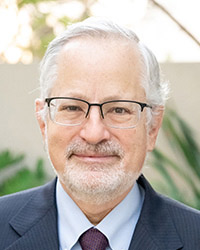In insurance defense attorney Dennis Kass’ world, litigation financing firms lurk behind the scenes, pushing plaintiffs to undergo as much treatment as possible so lawyers can maximize the value of claims.
“In a lot of ways, the plaintiffs become pawns in somebody else’s game,” said Kass, a founding partner of the Manning Kass law firm in San Francisco. “And its a dangerous game, and its kind of a sick game really. But there’s a lot of money at stake here. This is not a small industry.”
Law professor Kenneth Klein lives on the same planet, but he says his world view is shaped by data. Klein, who teaches at the California Western College of Law in San Diego, said a study released in April by Harvard Business School and Stanford University economics professors found that litigation funders actually produce a net benefit.

“These two economists actually modeled the problem and they concluded that on the whole it was very much a benefit if you are trying to reduce unethical behavior because the involvement of litigation financiers primarily eliminate unethical behavior on the defense side and they didn’t see much of it on the plaintiff side,” he said.
Kass and Klein participated in an online panel discussion Thursday hosted by the Coalition Against Insurance Fraud examining the “good, the bad and the ugly” of litigation financing. Matt Lehman, a Republican state representative from Indiana, and Eric Schuller, president of the Alliance for Responsible Consumer Legal Funding in Washington D.C., also spoke during the webinar.
Schuller’s organization represents litigation finance companies that focus on small loans to consumers to pay living expenses while they pursue litigation. His group supports state legislation to regulate the consumer litigation financing to ensure financiers behave professionally, fairly and equitably.
Related article: Commercial Litigation Funding and Social Inflation: A Non-Sequitur
Schuller said his industry makes it possible for people limited means to survive while they pursue their legal claims. He said acceptance of consumer legal funding—once banned by champerty laws—grew during the civil rights movement, when organizations such as the NAACP helped plaintiffs with their household expenses while they pursued lawsuits against organizations that discriminated against them.
“The litigation financier is spending their own money,” Schuller said. “They become themselves a screening device to sort out the wheat from chaff in the merits of a claim.”

The Coalition displayed a map that showed 14 states that have enacted legislation on litigation financing. Most of those laws address the consumer side. Lehman, for example, was behind a bill that passed in Indiana limiting interest rates for consumer litigation loans to 36%. This year, the Indiana legislature passed a bill that requires disclosure of litigation funding contracts to opposing parties.
Some states went too far. Schuller said consumer litigation lenders are not active in Arkansas and West Virginia because those states limited interest rates to 17% and 18 percent, respectively. He said the cost of capital is too great to earn any profit with rates capped that low.
Schuller said other than a few disclosure laws such as Indiana’s, the commercial side of litigation funding is largely unregulated. He said that may be because lawmakers view such financial arrangements as business-to-business contracts.
Kass said in concept, litigation financing is a great idea. “It makes sense to level the playing field.”
But Kass said California’s experience with Proposition 65 shows how some good ideas can go wrong. The ballot measure approved by voters in 1986 requires businesses to post notices of any hazardous materials contained in their products or on their premises.
“It is now the source of the biggest shakedown lawsuits in the state,” he said.
Kass said unregulated litigation financiers are driving explosive growth in the size of verdicts.
“We have really robust laws in the United States on the corporate practice of medicine. We want someone who is has taken the Hippocratic oath to control medical care.”
But with litigation financing, Kass said its the “wild, wild West.”
“Anytime you have something that is unregulated and acting in the dark, it leads to abuse,” Kass said. “We’re seeing some of these little PI (personal injury) attorneys taken over by the ligation funders. They are controlling the doctors that the plaintiffs go to.”
Kass said occasionally he is able to learn about a litigation finance agreement by searching public records for Uniform Commercial Code filings by major funders. But he said doctors who treat plaintiffs never want to talk about those funding arrangements when they are deposed.
“Conservative treatment, consisting of chiropractic manipulation, is not good for investors,” Kass said. “They don’t make much money. A claim with epidural injections, that leads to good money.”
Klein said he agrees that there are bad actors in the litigation funding space, but there are also “go-to doctors” for insurers who offer only opinions that benefit defendants.
Klein said nuclear verdicts don’t become judgments if they are not supported by evidence. He said the legal system has safeguards to ensure that the amount of damages awarded by juries are not overblown. And sometimes large awards are just.
“If you get to a nuclear judgment, that is evidence that somebody acted really badly,” Klein said.
Kass and Klein agreed on one thing: Both lawyers said the public would benefit if litigation funding agreements were fully disclosed.
But Klein said that should work both ways. Plaintiffs should have access to the defense attorney’s agreement with the insurer. He said plaintiffs also should be able to learn whether the insurance company’s claims adjuster has a financial incentive to reduce the payout.
“I think there should be full transparency,” Klein said.
This article was originally published by Claims Journal. Reporter Jim Sams in the editor of Claims Journal.





















 Executives on the Move at Liberty Mutual, Cowbell, W. R. Berkley
Executives on the Move at Liberty Mutual, Cowbell, W. R. Berkley  Underwriter, Actuary Fears of AI Drop; Work Needed on Collaboration
Underwriter, Actuary Fears of AI Drop; Work Needed on Collaboration  Berkshire Hathaway Enters Post-Buffett Era as Share Prices Fall
Berkshire Hathaway Enters Post-Buffett Era as Share Prices Fall  How Insurers Can Avoid Post-Merger Technology Failure
How Insurers Can Avoid Post-Merger Technology Failure 
